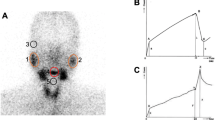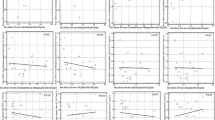Abstract
Purpose: The aim of this study was to evaluate the changes in salivary gland function in patients with chronic renal failure (CRF) undergoing hemodialysis.Methods: The group consisted of 23 patients with CRF (13 female, 10 male; mean age: 40±13 yr) and 14 healthy control subjects (mean age: 40±13 yr). All underwent dynamic salivary gland scintigraphy with gustatory stimulation. After intravenous administration of99mTc pertechnetate, first, perfusion images at 2 seconds per frame were acquired for 1 minute, then dynamic images at 1 minute per frame were acquired for 45 minutes. At 30 minutes after injection, 10 ml lemon juice was given for 15 minutes as a gustatory stimulus. We obtained time-activity curves derived from regions of interest centered over the four major salivary glands. The following functional indices were calculated for each gland: the time of maximum radioactivity (Tmax) for the prestimulated period, the time of minimum radioactivity (Tmin), as an indicator of velocity of secretion after stimulation, and the Lem E5% value as an indicator of the secretion function.Results: When the patients with CRF undergoing hemodialysis were compared to the controls, there were statistically significant differences in Tmax, Tmin and Lem E5% values for bilateral parotid glands, and Tmin values for bilateral submandibular glands (p<0.05), there were no statistically significant differences in Tmax and Lem E5% values for bilateral submandibular glands. There were also significant differences in Tmax and Lem E5% values for bilateral parotid glands between mild oral problems and severe oral problems in patients with CRF (undergoing hemodialysis).Conclusion: In this study, prolonged Tmax and Tmin values, and decreased Lem E5% values for parotid glands and prolonged Tmin values for submandibular glands on salivary scintigraphy pointed out decreased parenchymatous and excretory function in patients with CRF undergoing hemodialysis.
Similar content being viewed by others
References
Kho HS, Lee SW, Chung SC, Kim YK. Oral manifestations and salivary flow rate, pH, and buffer capacity in patients with end-stage renal disease undergoing hemodialysis.Oral Surg Oral Med Oral Pathol Oral Radiol Endod 1999; 88: 316–319.
Earlbaum AM, Quinton PM. Elevated divalent ion concentrations in parotid saliva from chronic renal failure patients.Nephron 1981; 28 (2): 58–61.
Epstein SR, Mandel I, Scopp IW. Salivary composition and calculus formation in patients undergoing hemodialysis.J Periodontol 1980; 51: 336–338.
Kohn WG, Ship JA, Atkinson JC, Patton LL, Fox PC. Salivary gland99mTc-scintigraphy: a grading scale and correlation with major salivary gland flow rates.J Oral Pathol Med 1992; 21: 70074.
Yamashita T, Ino C, Tomoda K, Kumazawa T. Prognostic determination and submandibular function in Bell’s palsy. Dynamic testing with technetium Tc 99m.Arch Otolaryngol 1985; 111: 244–248.
van den Akker HP, Busemann-Sokole E. Absolute indications for salivary gland scintigraphy with99mTc-pertechnetate.Oral Surg Oral Med Oral Pathol 1985; 60: 440–447.
Bohuslavizki KH, Brenner W, Klutmann S, Hübner RH, Lassmann S, Feyerabend B, et al. Radioprotection of salivary gland by Amifostine in high-dose Radioiodine therapy.J Nucl Med 1998; 39: 1237–1242.
Bohuslavizki KH, Brenner W, Wolf H, Sippel C, Tonshoff G, Tinnemeyer, S, et al. Value of quantitative salivary gland scintigraphy in the early stage of Sjögren’s syndrome.Nucl Med Commun 1995; 16: 917–922.
Gavalda C, Bagan J, Scully C, Silvestre F, Milian M, Jimenez Y. Renal hemodialysis patients: oral, salivary, dental and periodental findings in 105 adult cases.Oral Dis 1999; 5 (4): 299–302.
Kao CH, Hsieh JF, Tsai SC, Ho YJ, Chang HR. Decreased salivary function in patients with end-stage renal disease requiring hemodialysis.Am J Kidney Dis 2000; 36 (6): 1110–1114.
Umehara I, Yamada I, Murata Y, Takahashi Y, Okada N, Shibuya H. Quantitative evaluation of salivary gland scintigraphy in Sjögren’s syndrome.J Nucl Med 1999; 40: 64–69.
Liem IH, Olmos RA, Balm AJ, Keus RB, van Tinteren H, Takes RP, et al. Evidence for early and persistent impairment of salivary gland excretion after irradiation of head and neck tumours.Eur J Nucl Med 1996; 23: 1485–1490.
Author information
Authors and Affiliations
Corresponding author
Rights and permissions
About this article
Cite this article
Kaya, M., Çermik, T.F., Üstün, F. et al. Salivary function in patients with chronic renal failure undergoing hemodialysis. Ann Nucl Med 16, 117–120 (2002). https://doi.org/10.1007/BF02993714
Received:
Accepted:
Issue Date:
DOI: https://doi.org/10.1007/BF02993714




